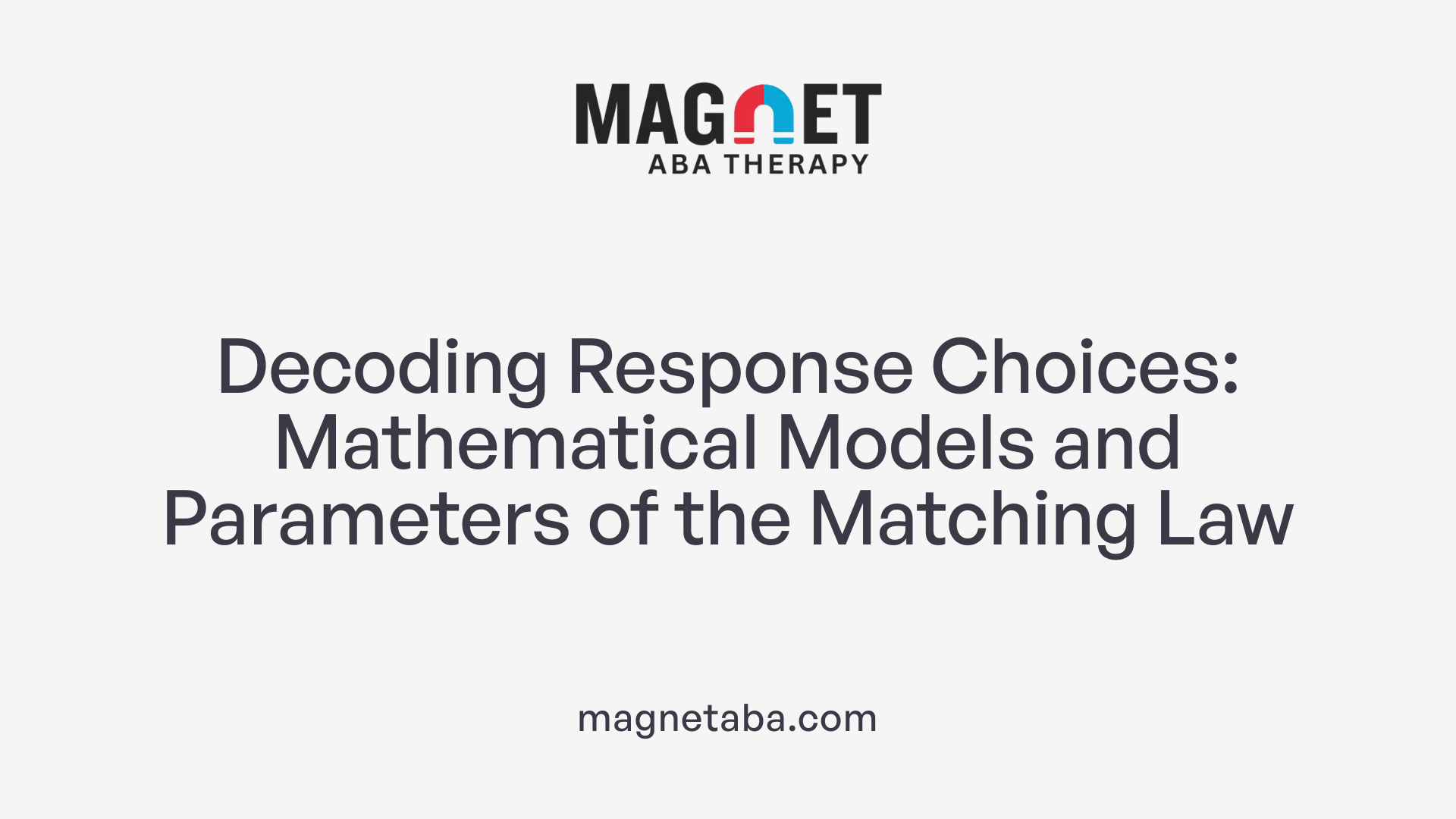Exploring the Foundations of the Matching Law in Behavior Analysis
The matching law is a pivotal concept in behavior analysis that explains how individuals distribute their responses across multiple options based on reinforcement. First formalized in 1961 by R.J. Herrnstein through pigeon studies, it provides a quantitative framework that links response rates to reinforcement rates, playing a vital role in understanding and shaping behavior. This article delves into the basic principles of the matching law, its application in ABA therapy, and practical examples illustrating its effectiveness.
The Core Concept of the Matching Law
What is the basic principle behind the matching law in behavior analysis?
The core idea of the matching law is that response behavior is proportional to the reinforcement received for that behavior. If one response option is reinforced more frequently relative to others, an organism tends to allocate more responses to that option. This principle helps explain how individuals choose among behaviors when multiple options are available simultaneously.
How does reinforcement influence behavior in concurrent schedules?
In situations involving concurrent reinforcement schedules, multiple behaviors are reinforced at the same time. The matching law states that individuals tend to respond in a manner proportional to the reinforcement each behavior receives. For instance, if a person receives twice as much reinforcement for doing task A than task B, they are likely to perform task A roughly twice as often.
| Behavior | Response Rate | Reinforcement Rate | Response/Reinforcement Ratio |
|---|---|---|---|
| A | B1 | Rf1 | B1/Rf1 |
| B | B2 | Rf2 | B2/Rf2 |
This table illustrates how response allocation aligns with reinforcement ratios.
Mathematical Relationship
The matching law can be expressed mathematically. For example, the basic formula R1/(R1+R2) = Rf1/(Rf1+Rf2) links the response rates (R1, R2) to reinforcement rates (Rf1, Rf2). It demonstrates that response proportions reflect reinforcement proportions.
In practice, this means increasing reinforcement for a desired behavior can lead to more frequent responding. Conversely, reducing reinforcement for maladaptive behaviors can diminish their occurrence.
Practical Application
The matching law offers an effective alternative to extinction procedures, often avoiding side effects like aggression or extinction bursts. To implement this, understanding the functions of behaviors and all sources of reinforcement is essential.
By manipulating reinforcement schedules based on the matching law, therapists and behavior analysts can shape behavior more predictably, whether in clinical settings such as autism interventions or in everyday situations.
Mathematical Foundations and Parameters of the Law

What are the hyperbolic and linear models of response allocation?
The matching law can be represented through different mathematical models that describe how responses are distributed based on reinforcement. The simplest form is the linear model, where response ratios directly match reinforcement ratios, expressed as R1/(R1+R2) = Rf1/(Rf1+Rf2).
However, real-world behavior often shows deviations, leading to the hyperbolic model—also called Herrnstein's hyperbola—which accounts for cases where responses are less or more responsive than reinforcement. The hyperbolic model describes a nonlinear relationship, suggesting that responses tend to asymptote toward certain limits, which better fits observed data in many settings.
Parameters such as bias (b) and sensitivity (s) in response behavior
Beyond the basic models, the generalized matching law introduces two important parameters that modify response predictions:
Bias (b): Represents a preference toward one response over another, even if reinforcement rates are equal. For instance, a person might favor a particular activity regardless of reinforcement patterns.
Sensitivity (s): Indicates how responsive the response ratio is to changes in reinforcement ratio. A higher s value implies responses closely follow reinforcement ratios, while a lower s indicates weaker sensitivity, reflecting more variability or bias.
These parameters are typically estimated through regression analysis, enabling practitioners to understand and predict individual response patterns.
How do these mathematical expressions predict behavior choice?
Using these models, behavior analysts can forecast how changes in reinforcement schedules will influence response allocation. For example, increasing the reinforcement magnitude for a specific behavior should increase responses toward that behavior, as indicated by the models.
The regression-based parameters help interpret deviations from perfect matching, such as undermatching (less responding than predicted), overmatching (more responding), or bias. These insights guide how reinforcement schedules are manipulated to shape desired behaviors effectively.
| Model Type | Response Relation | Reinforcement Relation | Additional Details |
|---|---|---|---|
| Linear | Response ratio = Reinforcement ratio | R1/(R1+R2) = Rf1/(Rf1+Rf2) | Assumes perfect proportionality |
| Hyperbolic | Response follows a hyperbolic curve | Response correlated with hyperbolic function | Accounts for deviations in behavior |
| Generalized | Response ratio = Bias × (Reinforcement ratio)^s | Incorporates bias (b) and sensitivity (s) | More flexible, covers variations |
Understanding these mathematical frameworks allows practitioners to predict behavior and design reinforcement strategies that effectively promote adaptive responses.
Application and Significance in Behavior Analysis
 The matching law offers valuable insights into how individuals distribute their responses based on reinforcement ratios. It explains that response allocation is proportional to the reinforcement received from each behavior, providing a clear framework for understanding choice behavior in various settings.
The matching law offers valuable insights into how individuals distribute their responses based on reinforcement ratios. It explains that response allocation is proportional to the reinforcement received from each behavior, providing a clear framework for understanding choice behavior in various settings.
The basic idea is straightforward: if one behavior is reinforced more often, responses tend to favor that behavior. In applied behavior analysis (ABA), this principle guides therapists in shaping responses by manipulating reinforcement schedules. For instance, increasing reinforcement for desired behaviors encourages clients to respond more often in line with those contingencies.
However, real-world applications often involve deviations from perfect matching. These include undermatching, where responses are less sensitive to reinforcement differences; overmatching, where responses are overly biased toward certain options; and bias, where responses favor one behavior regardless of reinforcement rates. To account for these behaviors, the generalized matching law introduces parameters like bias (b) and sensitivity (s), which help gauge how closely actual response patterns follow reinforcement ratios.
Understanding these variations is crucial for designing effective interventions, especially in complex environments like natural settings or clinical treatments. Researchers and practitioners use models based on the matching law to interpret response patterns, predict future behaviors, and adjust reinforcement strategies accordingly.
In summary, the matching law serves as a fundamental tool in behavior analysis. It clarifies how reinforcement influences response choices and provides a quantitative basis for modifying behaviors through carefully structured reinforcement schedules.
| Concept | Explanation | Relevance |
|---|---|---|
| Response allocation | How responses are divided based on reinforcement | Guides behavior shaping |
| Deviations | Undermatching, overmatching, bias | Highlights complexity in real-world behaviors |
| Parameters | Bias (b), sensitivity (s) | Adjustments in models to fit observed behaviors |
| Practical application | Adjusting reinforcement schedules | Improves intervention effectiveness |
Response allocation and reinforcement are central to understanding and predicting behavior, making the matching law an essential principle in both research and applied settings.
Historical Context and Empirical Evidence

What is the basic principle behind the matching law in behavior analysis?
The matching law states that the proportion of responses made by an organism aligns with the proportion of reinforcement it receives from those responses. In simple terms, if one response consistently yields more reinforcement, the organism is more likely to choose that response more often, maintaining a balance that reflects reinforcement ratios.
Foundational research by Herrnstein and studies with pigeons
The origins of the matching law trace back to a landmark study by behavioral psychologist R.J. Herrnstein in 1961. Conducted with pigeons, the research demonstrated that the pigeons' response rates to two different keys corresponded proportionally to the reinforcement they received for pecking each key.
This experiment vividly illustrated that animals tend to distribute their responses in proportion to reinforcement availability across concurrent schedules. The findings effectively established a mathematical relationship between response rates and reinforcement rates, offering a formalized way to predict behavior under specific reinforcement contingencies.
Deviations from perfect matching such as undermatching and overmatching
While the basic law suggests a perfect proportional relationship, real-world observations often reveal deviations. Two common distortions are undermatching and overmatching.
- Undermatching occurs when response ratios are less extreme than reinforcement ratios, indicating that organisms respond less selectively than predicted.
- Overmatching happens when response ratios are more extreme, suggesting an over-preference or over-responsiveness to certain options.
Researchers have extended the original model to account for these deviations through the generalized matching law, which introduces parameters for bias and sensitivity, helping to explain why actual behavior might diverge from ideal proportionality.
Research in clinical settings including autism and developmental disabilities
Empirical research has extended the application of the matching law to clinical settings, particularly with individuals diagnosed with autism and other developmental disabilities. Studies have shown that behavior patterns in these populations often follow the principles of the matching law.
Applied behavior analysts utilize this knowledge to shape and modify behaviors by adjusting reinforcement schedules. For example, increasing the reinforcement magnitude for desired behaviors can boost their frequency, while decreasing reinforcement for maladaptive behaviors can reduce their occurrence.
This approach not only aids in developing more effective intervention strategies but also provides a framework for understanding response allocation across various environments, enhancing the effectiveness of behavioral therapies.
| Aspect | Details | Additional Notes |
|---|---|---|
| Origin | Herrnstein's 1961 studies with pigeons | Demonstrated response-reinforcement proportionality |
| Deviations | Undermatching and overmatching | Addressed by the generalized matching law |
| Clinical applications | Autism and developmental disabilities | Guides reinforcement-based interventions |
| Mathematical expression | R1/(R1+R2) = Rf1/(Rf1+Rf2) | Describes response and reinforcement ratios |
| Practical importance | Predicting and shaping responses in various settings | Used in ABA therapy and behavior management |
Practical Implementation in ABA Therapy and Behavior Modification
How can reinforcement schedules and the matching law be used to influence behavior?
In Applied Behavior Analysis (ABA), therapists leverage the principles of the matching law by carefully adjusting reinforcement schedules to guide behavior choices. When multiple behaviors are reinforced simultaneously—known as concurrent schedules—behavior tends to distribute proportionally to the reinforcement received for each response. For example, if a child receives more reinforcement for sharing than for tantrums, over time, the child is more likely to share, aligning with the matching law.
One effective strategy is implementing token economies, where tokens serve as conditioned reinforcers that can be exchanged for preferred items or activities. By reinforcing desirable behaviors with tokens in proportion to their value, therapists can shape response allocation. Similarly, differential reinforcement involves reinforcing a specific behavior while withholding reinforcement for others, promoting preferred responses in line with reinforcement availability.
Adjusting the magnitude or frequency of reinforcement is another practical approach. Increasing reinforcement for targeted, adaptive behaviors boosts their occurrence, whereas decreasing reinforcement for problematic behaviors diminishes their prevalence. For example, providing more attention or praise when a child appropriately requests items encourages more of that behavior.
Understanding how responses are allocated according to the matching law allows therapists to design interventions that are both effective and sustainable. By analyzing response patterns and reinforcement rates, they can modify schedules to favor adaptive behaviors, reducing reliance on punishment or extinction procedures.
| Strategy | Description | Example |
|---|---|---|
| Reinforcement Schedule Adjustment | Modulating reinforcement to balance response allocation. | Increasing praise for sharing, decreasing attention for tantrums. |
| Token Economies | Using conditioned tokens to reinforce behaviors in proportion to their value. | Reward tokens for completing chores; exchange against preferred activities. |
| Differential Reinforcement | Reinforcing specific positive behaviors while withholding reinforcement for maladaptive ones. | Reinforcing eye contact, ignoring disruptive behaviors. |
| Response Cost | Removing reinforcement contingent on undesired behaviors. | Taking away tokens after noncompliance. |
What are practical examples of applying the matching law in ABA therapy and behavior modification?
Practical applications of the matching law involve systematically shaping behavior by aligning reinforcement with the responses desired. For instance, if a child exhibits tantrums to gain attention, treatments might focus on reinforcing appropriate requesting behaviors—like using words or gestures—more frequently. Reinforcing these alternative behaviors proportionally to their occurrence encourages a behavioral shift.
Another example is adjusting reinforcement to favor socially acceptable responses over undesired ones. If a child is more likely to engage in problematic behaviors because they are reinforced more often, a therapist can increase reinforcement for appropriate responses such as sharing or calm vocalizations. As reinforcement becomes more balanced, the child's behaviors tend to shift toward these more functional responses.
This approach often involves using token economies or differential reinforcement strategies to ensure that the preferred behaviors are reinforced in proportion to their value. Such practices help in establishing sustainable behavioral changes indeed aligned with the principles of the matching law.
How does understanding the matching law improve ABA interventions?
A clear understanding of the matching law equips therapists with a scientific framework for modifying behavior through reinforcement. It allows them to analyze response patterns and reinforcement contingencies, predicting which behaviors are likely to increase with specific reinforcement configurations. This targeted approach enables more precise interventions, such as increasing reinforcement for desired behaviors and reducing reinforcement for maladaptive ones.
Moreover, it minimizes the heavy reliance on punishment or extinction procedures that can have adverse side effects like extinction bursts or aggression. By manipulating reinforcement systematically, therapists can promote sustainable behavior change and teach new skills more effectively.
In summary, the matching law provides a valuable model for designing effective, evidence-based behavior interventions that are responsive to an individual’s reinforcement history and preferences, helping to achieve better, longer-lasting outcomes.
Concluding Insights and Future Directions

Why is understanding reinforcement dynamics important?
The matching law emphasizes how response allocation is directly influenced by reinforcement rates. Recognizing this relationship helps practitioners predict behavioral patterns when multiple responses are reinforced simultaneously. By understanding how behaviors are guided by reinforcement, behavior analysts can design more effective interventions and modify environments to promote desirable behaviors.
How can the matching law help in tailoring behavior interventions?
Since the law demonstrates that increasing reinforcement for desired behaviors can increase their occurrence, and reducing reinforcement for maladaptive behaviors can decrease their frequency, interventions can be customized accordingly. For instance, adjusting reinforcement schedules to favor positive behaviors while decreasing the reinforcement of problematic actions can shape responses effectively.
What is the potential for ongoing research and validation across diverse populations?
Research continues to expand the understanding of response allocation beyond initial studies. In particular, studies involving children with autism and other developmental disabilities show the law’s applicability in various contexts. Future investigations aim to refine mathematical models, account for real-world complexities such as biases and sensitivities, and explore how this principle can be applied universally when considering different reinforcement sources.
How might this support future applications?
Advances in understanding reinforcement dynamics will enhance personalized behavior programs, improve intervention effectiveness, and help predict responses in complex environments. This ongoing research encourages the adaptation of behavioral strategies that are scientifically grounded and tailored to individual needs.
Response allocation and reinforcement interplay
The principles of the matching law, as summarized in the response ratios and reinforcement ratios, remain fundamental. Deviations such as undermatching or overmatching highlight the importance of considering individual differences and environmental factors. Continued validation and refinement of these models will strengthen their use in clinical and natural settings.
| Area of Focus | Description | Future Direction |
|---|---|---|
| Theoretical models | Hyperbolic and linear matching functions | Improve predictive accuracy in complex scenarios |
| Practical applications | Reinforcement adjustments in therapy | Develop personalized interventions |
| Population scope | Autism, ADHD, behavioral disorders | Expand research to diverse groups |
| Modeling parameters | Bias and sensitivity | Enhance understanding of individual response patterns |
Summarizing the Impact of the Matching Law on Behavior Change Strategies
The matching law remains a cornerstone of behavior analysis, offering a scientific basis for understanding and influencing how responses are allocated based on reinforcement. Its principles underpin many contemporary ABA practices, facilitating effective, individualized interventions. As research progresses, the law’s application continues to expand across various populations and settings, reinforcing its vital role in behavior modification and clinical practice.











